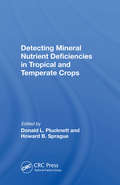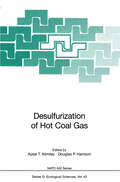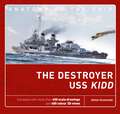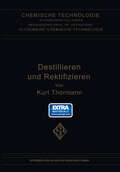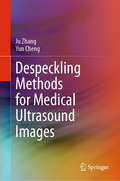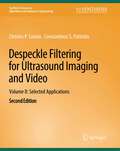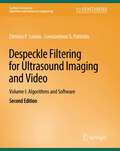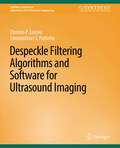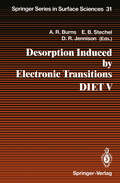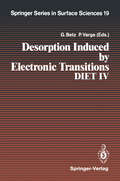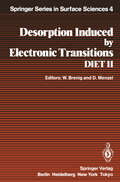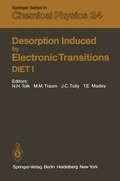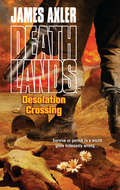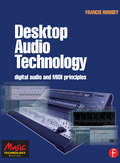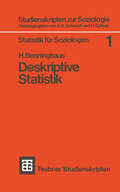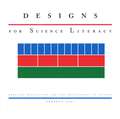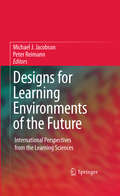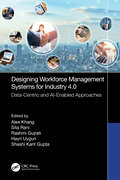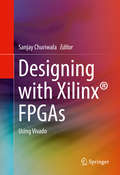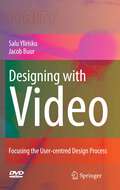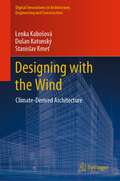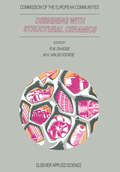- Table View
- List View
Detecting Mineral Nutrient Deficiencies In Tropical And Temperate Crops
by Donald L PlucknettThis book deals an essential aspect of crop management in identification of deficiencies of plant nutrients and their diagnostic methods. The book provides soil and tissue analysis standards critical in plant nutrition.
Desulfurization of Hot Coal Gas (Nato ASI Subseries G: #42)
by Aysel T. Atimtay Douglas P. HarrisonEconomic and environmental requirements for advanced power generating systems demand the removal of corrosive and other sulfurous compounds from hot coal gas. After a brief account of the world energy resources and an overview of clean coal technologies, a review of regenerable metal oxide sorbents for cleaning the hot gas is provided. Zinc oxide, copper oxide, calcium oxide, manganese oxide based as well as supported and mixed metal oxide sorbents are treated. Performance analysis of these sorbents, effects of various parameters on the desulfurization efficiency, kinetics of sulfidation and regeneration reactions, sulfiding and regeneration mechanisms are discussed. Two chapters present recent results in the direct production of elemental sulfur from regeneration or SO2-rich gases.
The Destroyer USS Kidd (Anatomy of The Ship)
by Stefan DraminskiA brilliantly detailed visual representation of the only US World War II destroyer to have retained its original configuration.Superbly illustrated with artwork of the ship through its career, reconstructions of deck layouts, and 3D illustrations of every detail of the ship from its rigging to its boats to its anchors, this book reconstructs and dissects the Fletcher-class destroyer USS Kidd, the most original survivor of the US Navy's most famous class of World War II destroyers. Kidd fought throughout the Pacific War, in the Marshall Islands, Marianas, and Philippines campaigns. In early 1945, Kidd joined Task Force 58 for the invasion of Okinawa, and postwar served in the Korean War. Since 1982 USS Kidd has been a museum ship at Baton Rouge, Louisiana.Drawing on Stefan Draminski's new research and making the best use yet of his acclaimed 3D illustration techniques, this is the most comprehensive examination of USS Kidd ever published. It includes a complete set of detailed line drawings with fully descriptive keys and full-color 3D artwork, supported by technical details, photographs, and a concise history of the ship's construction and service.
Destillieren und Rektifizieren (Chemische Technologie in Einzeldarstellungen)
by Kurt ThormannDieser Buchtitel ist Teil des Digitalisierungsprojekts Springer Book Archives mit Publikationen, die seit den Anfängen des Verlags von 1842 erschienen sind. Der Verlag stellt mit diesem Archiv Quellen für die historische wie auch die disziplingeschichtliche Forschung zur Verfügung, die jeweils im historischen Kontext betrachtet werden müssen. Dieser Titel erschien in der Zeit vor 1945 und wird daher in seiner zeittypischen politisch-ideologischen Ausrichtung vom Verlag nicht beworben.
Despeckling Methods for Medical Ultrasound Images
by Ju Zhang Yun ChengBased upon the research they have conducted over the past decade in the field of denoising processes for medical ultrasonic imaging, in this book, the authors systematically present despeckling methods for medical ultrasonic images. Firstly, the respective methods are reviewed and divided into five categories. Secondly, after introducing some basic mathematical tools such as wavelet and shearlet transforms, the authors highlight five recently developed despeckling methods for medical ultrasonic images. In turn, simulations and experiments for clinical ultrasonic images are presented for each method, and comparison studies with other well-known existing methods are conducted, showing the effectiveness and superiority of the new methods. Students and researchers in the field of signal and image processing, as well as medical professionals whose work involves ultrasonic diagnosis, will greatly benefit from this book. Familiarizing them with the state of the art in despeckling methods for medical ultrasonic images, it offers a useful reference guide for their study and research work.
Despeckle Filtering for Ultrasound Imaging and Video, Volume II: Selected Applications, Second Edition (Synthesis Lectures on Algorithms and Software in Engineering)
by Christos P. Loizou Constantinos S. PattichisIn ultrasound imaging and video visual perception is hindered by speckle multiplicative noise that degrades the quality. Noise reduction is therefore essential for improving the visual observation quality or as a pre-processing step for further automated analysis, such as image/video segmentation, texture analysis and encoding in ultrasound imaging and video. The goal of the first book (book 1 of 2 books) was to introduce the problem of speckle in ultrasound image and video as well as the theoretical background, algorithmic steps, and the MatlabTM for the following group of despeckle filters: linear despeckle filtering, non-linear despeckle filtering, diffusion despeckle filtering, and wavelet despeckle filtering. The goal of this book (book 2 of 2 books) is to demonstrate the use of a comparative evaluation framework based on these despeckle filters (introduced on book 1) on cardiovascular ultrasound image and video processing and analysis. More specifically, the despeckle filtering evaluation framework is based on texture analysis, image quality evaluation metrics, and visual evaluation by experts. This framework is applied in cardiovascular ultrasound image/video processing on the tasks of segmentation and structural measurements, texture analysis for differentiating between two classes (i.e. normal vs disease) and for efficient encoding for mobile applications. It is shown that despeckle noise reduction improved segmentation and measurement (of tissue structure investigated), increased the texture feature distance between normal and abnormal tissue, improved image/video quality evaluation and perception and produced significantly lower bitrates in video encoding. Furthermore, in order to facilitate further applications we have developed in MATLABTM two different toolboxes that integrate image (IDF) and video (VDF) despeckle filtering, texture analysis, and image and video quality evaluation metrics. The code for these toolsets is open source and these are available to download complementary to the two monographs.
Despeckle Filtering for Ultrasound Imaging and Video, Volume I: Algorithms and Software, Second Edition (Synthesis Lectures on Algorithms and Software in Engineering)
by Christos P. Loizou Constantinos S. PattichisIt is well known that speckle is a multiplicative noise that degrades image and video quality and the visual expert's evaluation in ultrasound imaging and video. This necessitates the need for robust despeckling image and video techniques for both routine clinical practice and tele-consultation. The goal for this book (book 1 of 2 books) is to introduce the problem of speckle occurring in ultrasound image and video as well as the theoretical background (equations), the algorithmic steps, and the MATLABTM code for the following group of despeckle filters: linear filtering, nonlinear filtering, anisotropic diffusion filtering, and wavelet filtering. This book proposes a comparative evaluation framework of these despeckle filters based on texture analysis, image quality evaluation metrics, and visual evaluation by medical experts. Despeckle noise reduction through the application of these filters will improve the visual observation quality or it may be used as a pre-processing step for further automated analysis, such as image and video segmentation, and texture characterization in ultrasound cardiovascular imaging, as well as in bandwidth reduction in ultrasound video transmission for telemedicine applications. The aforementioned topics will be covered in detail in the companion book to this one. Furthermore, in order to facilitate further applications we have developed in MATLABTM two different toolboxes that integrate image (IDF) and video (VDF) despeckle filtering, texture analysis, and image and video quality evaluation metrics. The code for these toolsets is open source and these are available to download complementary to the two books. Table of Contents: Preface / Acknowledgments / List of Symbols / List of Abbreviations / Introduction to Speckle Noise in Ultrasound Imaging and Video / Basics of Evaluation Methodology / Linear Despeckle Filtering / Nonlinear Despeckle Filtering / Diffusion Despeckle Filtering / Wavelet Despeckle Filtering / Evaluation of Despeckle Filtering / Summary and Future Directions / References / Authors' Biographies
Despeckle Filtering Algorithms and Software for Ultrasound Imaging (Synthesis Lectures on Algorithms and Software in Engineering)
by Christos Loizou Constantinos PattichisIt is well-known that speckle is a multiplicative noise that degrades image quality and the visual evaluation in ultrasound imaging. This necessitates the need for robust despeckling techniques for both routine clinical practice and teleconsultation. The goal for this book is to introduce the theoretical background (equations), the algorithmic steps, and the MATLAB™ code for the following group of despeckle filters: linear filtering, nonlinear filtering, anisotropic diffusion filtering and wavelet filtering. The book proposes a comparative evaluation framework of these despeckle filters based on texture analysis, image quality evaluation metrics, and visual evaluation by medical experts, in the assessment of cardiovascular ultrasound images recorded from the carotid artery. The results of our work presented in this book, suggest that the linear local statistics filter DsFlsmv, gave the best performance, followed by the nonlinear geometric filter DsFgf4d, and the linear homogeneous mask area filter DsFlsminsc. These filters improved the class separation between the asymptomatic and the symptomatic classes (of ultrasound images recorded from the carotid artery for the assessment of stroke) based on the statistics of the extracted texture features, gave only a marginal improvement in the classification success rate, and improved the visual assessment carried out by two medical experts. A despeckle filtering analysis and evaluation framework is proposed for selecting the most appropriate filter or filters for the images under investigation. These filters can be further developed and evaluated at a larger scale and in clinical practice in the automated image and video segmentation, texture analysis, and classification not only for medical ultrasound but for other modalities as well, such as synthetic aperture radar (SAR) images. Table of Contents: Introduction to Ultrasound Imaging / Despeckle Filtering Algorithms / Evaluation Methodology / Applications of Despeckle Filtering in Ultrasound Imaging / Comparison and Discussion of Despeckle Filtering Algorithms / Summary and Future Directions
Desorption Induced by Electronic Transitions DIET V: Proceedings of the Fifth International Workshop, Taos, NM, USA, April 1–4, 1992 (Springer Series in Surface Sciences #31)
by Alan R. Burns Ellen B. Stechel Dwight R. JennisonThis volume in the Springer Series on Surface Sciences presents a recent account of advances in the ever-broadening field of electron-and photon-stimulated sur face processes. As in previous volumes, these advances are presented as the proceedings of the International Workshop on Desorption Induced by Electronic Transitions; the fifth workshop (DIET V) was held in Taos, New Mexico, April 1-4, 1992. It will be abundantly clear to the reader that "DIET" is not restricted to desorption, but has for several years included photochemistry, non-thermal surface modification, exciton self-trapping, and many other phenomena that are induced by electron or photon bombardment. However, most stimulated surface processes do share a common physics: initial electronic excitation, localization of the excitation, and conversion of electronic energy into nuclear kinetic energy. It is the rich variation of this theme which makes the field so interesting and fruitful. We have divided the book into eleven parts in order to emphasize the wide range of materials that are examined and to highlight recent experimental and theoretical advances. Naturally, there is considerable overlap between sections, and many papers would be appropriate in more than one part. Part I focuses on perhaps the most active area in the field today: electron attachment. Here the detection and characterization of negative ions formed by attachment of elec trons supplied externally from the vacuum are discussed. In addition, the first observations of negative ions formed by substrate photoelectrons are presented.
Desorption Induced by Electronic Transitions DIET IV: Proceedings of the Fourth International Workshop, Gloggnitz, Austria, October 2–4, 1989 (Springer Series in Surface Sciences #19)
by Gerhard Betz Peter VargaDesorption Induced by Electronic Transitions DIET II: Proceedings of the Second International Workshop, Schloß Elmau, Bavaria, October 15–17, 1984 (Springer Series in Surface Sciences #4)
by Wilhelm Brenig Dietrich MenzelThe second workshop on Desorption Induced by Electronic Transitions (DIET II) took place October 15-17, 1984, in SchloB Elmau, Bavaria. DIET II, fol lowing the great success of DIET I (edited by N. H. Tolk, M. M. Traum, J. C. Tully, T. E. Madey and published in Springer Ser. Chem. Phys. , Vol. 24), again brought together over 60 workers in this exciting field. The "hard co re of experts" was essentially the same as in DIET I but the general overlap of participants between the two meetings was small. While DIET I had the function of an exposition of the status of the field DIET II focussed more on new developments. The main emphasis was again on the microscopic under standing of DIET but a number of side aspects and the application of DIET ideas to other fields such as sputtering, laser-induced desorption, fractu re, erosion, etc. were considered, too. New mechanisms and new refined expe rimental techniques were proposed and discussed at the meeting critically but with great enthusiasm. In addition to the talks, there was a continuous poster exhibition which also stimulated extended and excited discussions. This book is a collection of papers summarizing the talks and posters presented at the meeting.
Desorption Induced by Electronic Transitions DIET I: Proceedings of the First International Workshop, Williamsburg, Virginia, USA, May 12–14, 1982 (Springer Series in Chemical Physics #24)
by N. H. Tolk M. M. Traum J. C. Tully T. E. MadeyThe Workshop on Desorption Induced by Electronic Transitions (DIET) took place May 12-14, 1982, in Williamsburg, Virginia. The meeting brought together, for the first time, most of the leading workers in the fields of electron and photon stimulated desorption from surfaces, as well as many workers in related fields, including sputtering, gas-phase photodissociation and solid-state theory. The emphasis of the workshop was on the microscopic mechanism of stimu lated desorption. Many possible mechanisms have been proposed, and a few new ones emerged at the meeting. Though no consensus was reached, many views were espoused and criticized, frequently with considerable enthusiasm. The result was an appraisal of our current understanding of DIET, and a focus on the experimental and theoretical efforts most likely to lead to new insights. This volume is an attempt to record the information exchanged in this very successful workshop and, perhaps, convey some of the excitement of the field of DIET. The book is a collection of papers written by participants in the DIET workshop, including in addition a contribution from Dietrich Menzel, who was unable to attend. Thus, this book represents a complete statement of the state of the art of experimental and theoretical studies of DIET and related phenomena. More importantly, it addresses the interesting unsolved problems, and suggests strategies for unraveling them. We acknowledge the assistance given by the other members of the organizing committee, A. E. de Vries, R. Gomer, M. L. Knotek, D. Menzel and D. P.
Desolation Crossing
by James AxlerSurvival is a dangerous enterprise in the aftermath of a nuked America. Humanity perseveres, but the Deathlands code is far simpler: kill or be killed, live or die trying. Driven by the fires of hope, a resilient band of warriors traverse the new frontier of the future, survivors by skill and legends by reputation.
Desktop Audio Technology: Digital audio and MIDI principles
by Francis RumseyIn this thorough introduction to the technology behind audio workstations, Dr Francis Rumsey explains not only how digital audio works but also how to make best use of its capabilities. A combined revision of his two successful titles, MIDI Systems and Control and The Audio Workstation Handbook, this new book covers recent developments such as surround sound formats, direct stream digital, new audio project formats, new interfaces and alternatives to MIDI.Desktop Audio Technology begins by setting out principles of digital audio and how these are applied in recording, replay and editing within workstations. MIDI and synthetic audio control is then covered, looking at the means by which artificial sounds can be controlled and manipulated. This is followed by explanations of hardware, including storage devices, buses, computer interfaces and audio processing options. Dr Rumsey then focuses on transferring audio between systems, including coverage of audio interfaces, networking and file formats. The next section examines audio software, providing working examples of different commercial packages that exemplify some of the concepts previously described. The final chapter considers operational issues such as recent spatial reproduction formats, consumer format mastering and quality control issues, as well as troubleshooting and systems issues.If you are a student, lecturer or practitioner in the field of audio and are looking for an authoritative technical guide to the underlying principles of digital audio and MIDI, this book is for you.Dr Francis Rumsey is a Reader in Sound Recording at the University of Surrey (UK) and a Visiting Professor at the School of Music in Piteå (Sweden). He is a Fellow of the Audio Engineering Society and a regular contributor to the AES Journal. Dr Rumsey is also author of Spatial Audio and co-author of Sound and Recording (with Tim McCormick) and The Digital Interface Handbook (with John Watkinson), all published by Focal Press.
Desktop Audio Technology: Digital audio and MIDI principles (Music Technology Ser.)
by Francis RumseyIn this thorough introduction to the technology behind audio workstations, Dr Francis Rumsey explains not only how digital audio works but also how to make best use of its capabilities. A combined revision of his two successful titles, MIDI Systems and Control and The Audio Workstation Handbook, this new book covers recent developments such as surround sound formats, direct stream digital, new audio project formats, new interfaces and alternatives to MIDI.Desktop Audio Technology begins by setting out principles of digital audio and how these are applied in recording, replay and editing within workstations. MIDI and synthetic audio control is then covered, looking at the means by which artificial sounds can be controlled and manipulated. This is followed by explanations of hardware, including storage devices, buses, computer interfaces and audio processing options. Dr Rumsey then focuses on transferring audio between systems, including coverage of audio interfaces, networking and file formats. The next section examines audio software, providing working examples of different commercial packages that exemplify some of the concepts previously described. The final chapter considers operational issues such as recent spatial reproduction formats, consumer format mastering and quality control issues, as well as troubleshooting and systems issues.If you are a student, lecturer or practitioner in the field of audio and are looking for an authoritative technical guide to the underlying principles of digital audio and MIDI, this book is for you.Dr Francis Rumsey is a Reader in Sound Recording at the University of Surrey (UK) and a Visiting Professor at the School of Music in Piteå (Sweden). He is a Fellow of the Audio Engineering Society and a regular contributor to the AES Journal. Dr Rumsey is also author of Spatial Audio and co-author of Sound and Recording (with Tim McCormick) and The Digital Interface Handbook (with John Watkinson), all published by Focal Press.
Designs for Science Literacy
by American Association for the Advancement of ScienceThe call for science curriculum reform has been made over and over again for much of the twentieth century. Arguments have been made that the content of the curriculum is not appropriate for meeting the individual and social needs of people living in the modern world; that the curriculum has become overstuffed with topics and does not serve students especially well; and above all, that the curriculum does not generate the student learning it is expected to produce. The latest volume in a continuing series of publications from the AAAS designed to reform science education, Designs for Science Literacy presupposes that curriculum reform must be considerably more extensive and fundamental than the tinkering with individual courses and subjects that has been going on for decades. Designs deals with the critical issues involved in assembling sound instructional materials into a new, coherent K-12 whole. The book pays special attention to the need to link science-oriented studies to the arts and humanities, and also proposes how to align the curriculum with an established set of learning goals while preserving the American tradition of local responsibility for the curriculum itself. If fundamental curriculum reform is ever to occur, a new process for creating alternatives will have to be developed. Designs for Science Literacy provides the groundwork for such a process.
Designs for Science Literacy: Critical Literacy Education Across The Lifespan
by American Association for the Advancement of ScienceThe call for science curriculum reform has been made over and over again for much of the twentieth century. Arguments have been made that the content of the curriculum is not appropriate for meeting the individual and social needs of people living in the modern world; that the curriculum has become overstuffed with topics and does not serve students especially well; and above all, that the curriculum does not generate the student learning it is expected to produce. The latest volume in a continuing series of publications from the AAAS designed to reform science education, Designs for Science Literacy presupposes that curriculum reform must be considerably more extensive and fundamental than the tinkering with individual courses and subjects that has been going on for decades. Designs deals with the critical issues involved in assembling sound instructional materials into a new, coherent K-12 whole. The book pays special attention to the need to link science-oriented studies to the arts and humanities, and also proposes how to align the curriculum with an established set of learning goals while preserving the American tradition of local responsibility for the curriculum itself. If fundamental curriculum reform is ever to occur, a new process for creating alternatives will have to be developed. Designs for Science Literacy provides the groundwork for such a process.
Designs for Learning Environments of the Future: International Perspectives from the Learning Sciences
by Peter Reimann Michael J. JacobsonFew things are as certain as societal changes—and the pressing need for educators to prepare students with the knowledge and ways of thinking necessary for the challenges in a changing world. In the forward-thinking pages of Designs for Learning Environments of the Future, international teams of researchers present emerging developments and findings in learning sciences and technologies at the infrastructure, curricular, and classroom levels.Focusing on ideas about designing innovative environments for learning in areas such as biology, engineering, genetics, mathematics, and computer science, the book surveys a range of learning technologies being explored around the world—a spectrum as diverse as digital media, computer modeling, and 3D virtual worlds—and addresses challenges arising from their design and use. The editors’ holistic perspective frames these innovations as not only discrete technologies but as flexible learning environments that foster student engagement, participation, and collaboration. Contributors describe possibilities for teaching and learning in these and other cutting-edge areas: Working with hypermodels and model-based reasoning Using visual representations in teaching abstract concepts Designing strategies for learning in virtual worlds Supporting net-based collaborative teams Integrating innovative learning technologies into schools Developing personal learning communities Designs for Learning Environments of the Future will enhance the work of a wide range of professionals, including researchers and graduate students in the learning and cognitive sciences, and educators in the physical and social sciences.
Designing Workforce Management Systems for Industry 4.0: Data-Centric and AI-Enabled Approaches
by Alex Khang Sita Rani Rashmi Gujrati Hayri Uygun Shashi GuptaThis book brings insight to the HR management system and offers data-centric approaches and AI-enabled applications for the design and implementation strategies used for workforce development and management. Designing Workforce Management Systems for Industry 4.0: Data-Centric and AI-Enabled Approaches focuses on the mechanisms of proposing solutions along with architectural concepts, design principles, smart solutions, and intelligent predictions with visualization simulation. Data visualization for the metrics of management systems and robotic process automation applications and tools are also offered. This book is also useful as a reference for those involved in AI-enabled applications, data analytics, data visualization, as well as systems engineering and systems designing.
Designing Workforce Management Systems for Industry 4.0: Data-Centric and AI-Enabled Approaches
by Alex Khang Sita Rani Rashmi Gujrati Hayri Uygun Shashi Kant GuptaThis book brings insight to the HR management system and offers data-centric approaches and AI-enabled applications for the design and implementation strategies used for workforce development and management. Designing Workforce Management Systems for Industry 4.0: Data-Centric and AI-Enabled Approaches focuses on the mechanisms of proposing solutions along with architectural concepts, design principles, smart solutions, and intelligent predictions with visualization simulation. Data visualization for the metrics of management systems and robotic process automation applications and tools are also offered. This book is also useful as a reference for those involved in AI-enabled applications, data analytics, data visualization, as well as systems engineering and systems designing.
Designing with Xilinx® FPGAs: Using Vivado
by Sanjay ChuriwalaThis book helps readers to implement their designs on Xilinx® FPGAs. The authors demonstrate how to get the greatest impact from using the Vivado® Design Suite, which delivers a SoC-strength, IP-centric and system-centric, next generation development environment that has been built from the ground up to address the productivity bottlenecks in system-level integration and implementation. This book is a hands-on guide for both users who are new to FPGA designs, as well as those currently using the legacy Xilinx tool set (ISE) but are now moving to Vivado. Throughout the presentation, the authors focus on key concepts, major mechanisms for design entry, and methods to realize the most efficient implementation of the target design, with the least number of iterations.
Designing with Video: Focusing the user-centred design process
by Salu Pekka Ylirisku Jacob BuurThis book illustrates in detail how digital video can be utilized throughout a design process, from the early user studies, through making sense of the video content and envisioning the future with video scenarios, to provoking change with video artifacts. The text offers first-hand case studies in both academic and industrial contexts, and is complemented by video excerpts. It is a must-read for those wishing to create value through insightful design.
Designing with the Wind: Climate-Derived Architecture (Digital Innovations in Architecture, Engineering and Construction)
by Lenka Kabošová Dušan Katunský Stanislav KmeťThis book explores wind-adaptive architectural design blending the parametric design with digital simulations and suggests a novel approach for specific, even extreme conditions, as the first step in creating architecture that can act in response to the nature around. The chapters propose an urban and architectural design that emerges from the specific wind microclimate of the design site and responds to the changes in the ambient wind conditions. The book looks closely at A) the interdisciplinary wind-driven design method for architects, engineers, and urbanists employing open-source software for CFD analysis and B) the tensegrity-membrane adaptive building façades. The main questions the authors try to answer are: How does the wind-driven methodology enhance the wind comfort around buildings? How can it contribute to the reduction of wind surface loads acting on buildings?
Designing with Structural Ceramics
by R. W. Davidge M. H. Van De VoordeThe last 30 years have seen a steady development in the range of ceramic materials with potential for high temperature engineering applications: in the 60s, self-bonded silicon carbide and reaction-bonded silicon nitride; in the 70s, improved aluminas, sintered silicon carbide and silicon nitrides (including sialons); in the 80s, various toughened Zr0 materials, ceramic matrix composites reinforced with silicon 2 carbide continuous fibres or whiskers. Design methodologies were evolved in the 70s, incorporating the principles of fracture mechanics and the statistical variation and time dependence of strength. These have been used successfully to predict the engineering behaviour of ceramics in the lower range of temperature. In spite of the above, and the underlying thermodynamic arguments for operations at higher temperatures, there has been a disappointing uptake of these materials in industry for high temperature usc. Most of the successful applications are for low to moderate temperatures such as seals and bearings, and metal cutting and shaping. The reasons have been very well documented and include: • Poor predictability and reliability at high temperature. • High costs relative to competing materials. • Variable reproducibility of manufacturing processes. • Lack of sufficiently sensitive non-destructive techniques. With this as background, a Europhysics Industrial Workshop sponsored by the European Physical Society (EPS) was organised by the Netherlands Energy Research Foundation (ECN) and the Institute for Advanced Materials of the Joint Research Centre (JRC) of the EC, at Petten, North Holland, in April 1990 to consider the status of thermomechanical applications of engineering ceramics.
